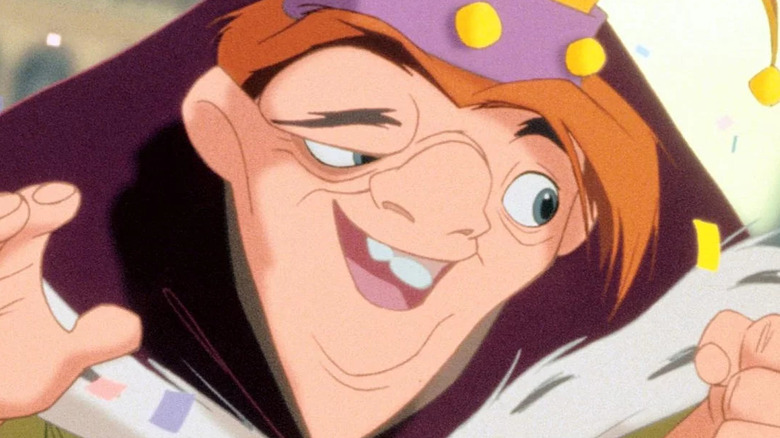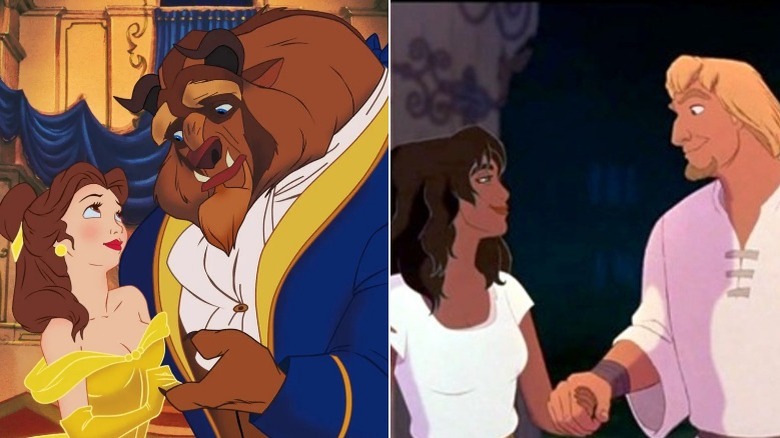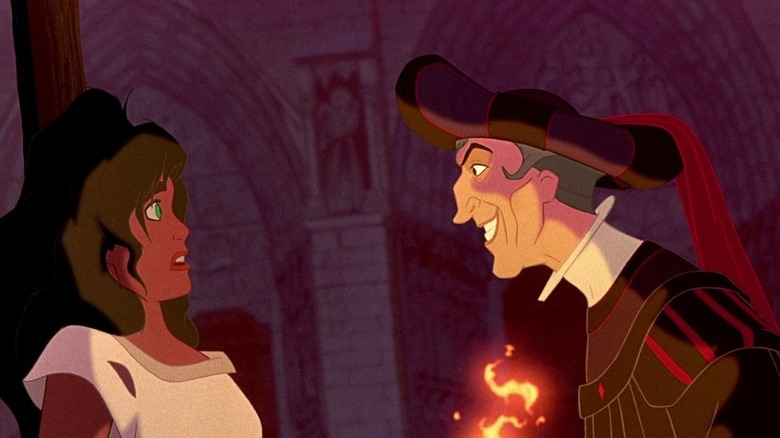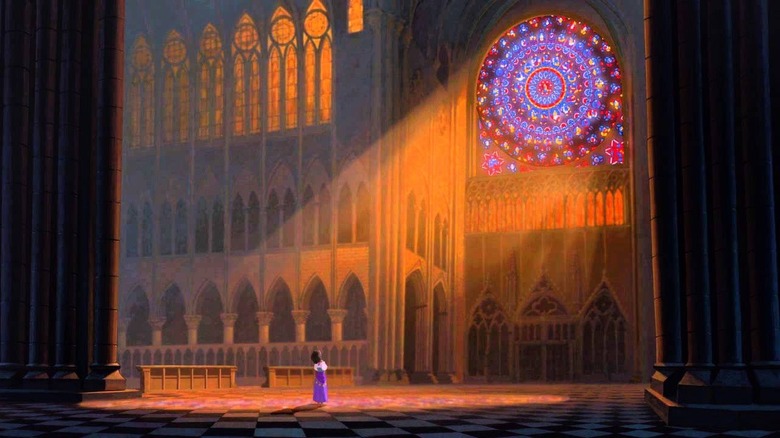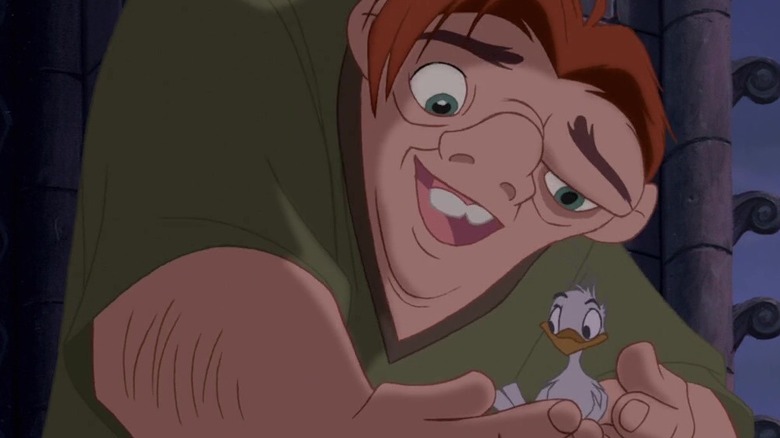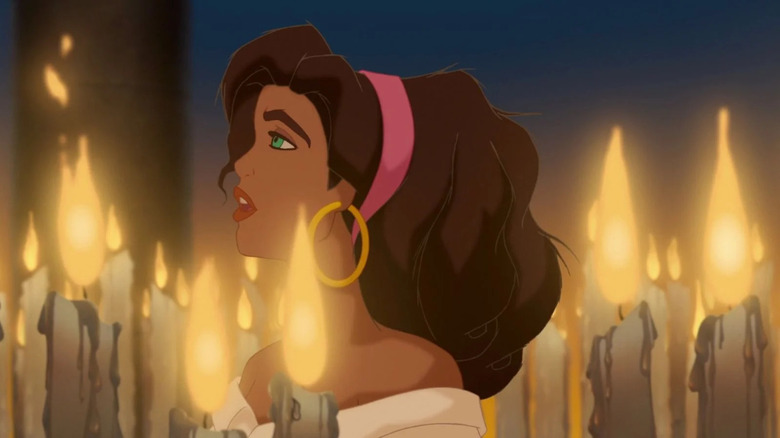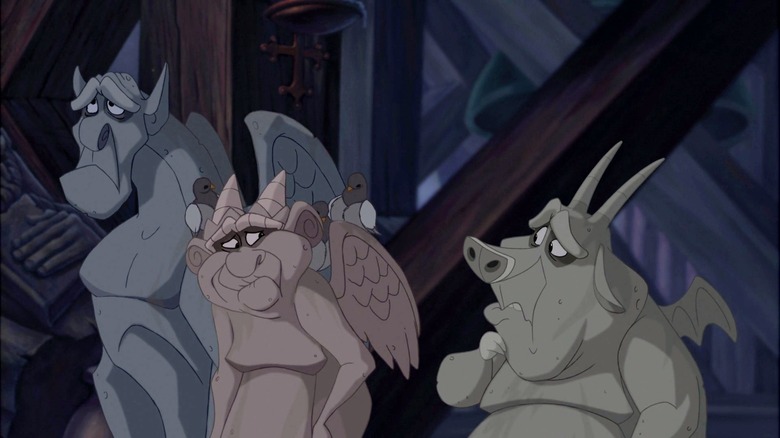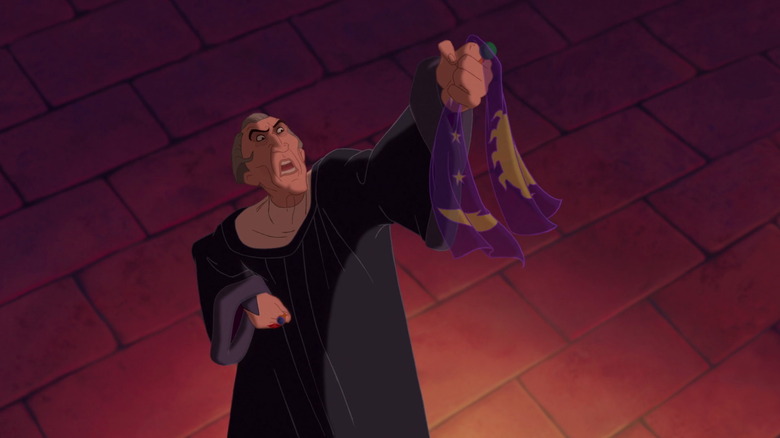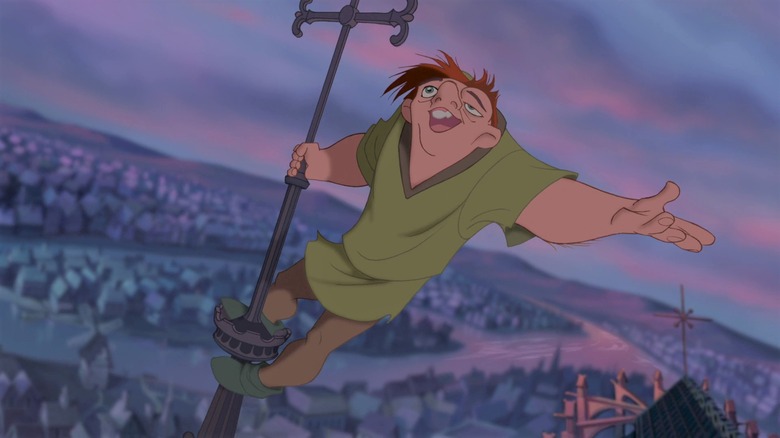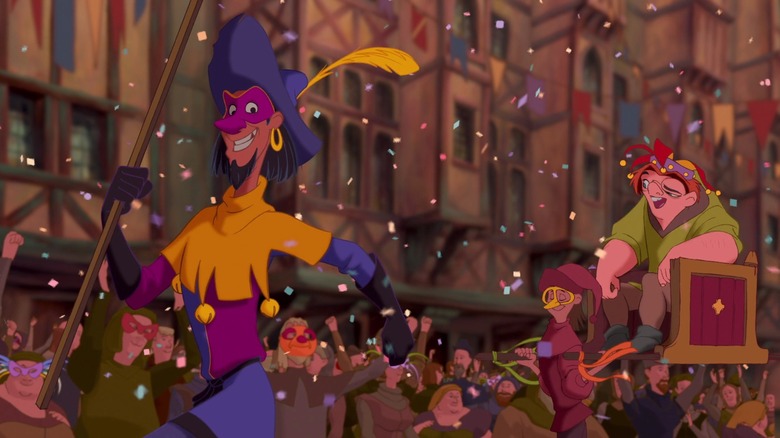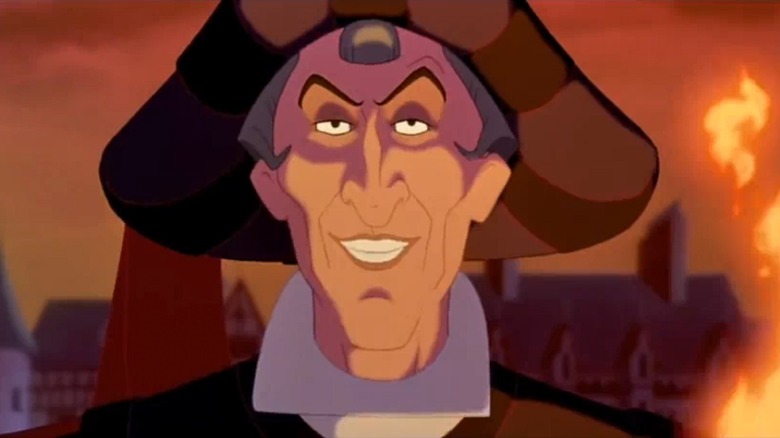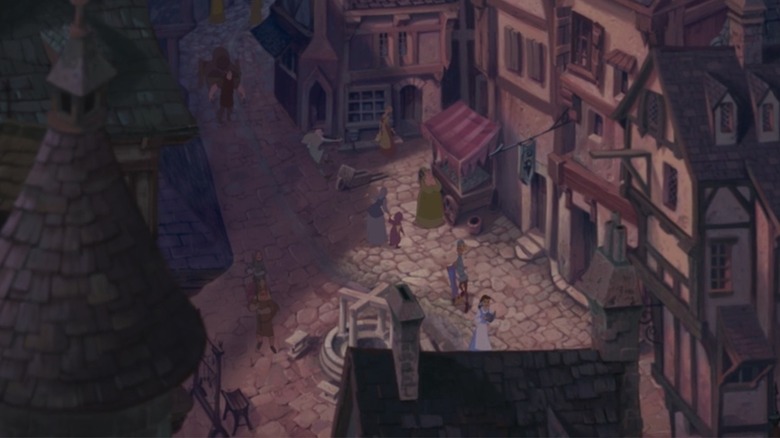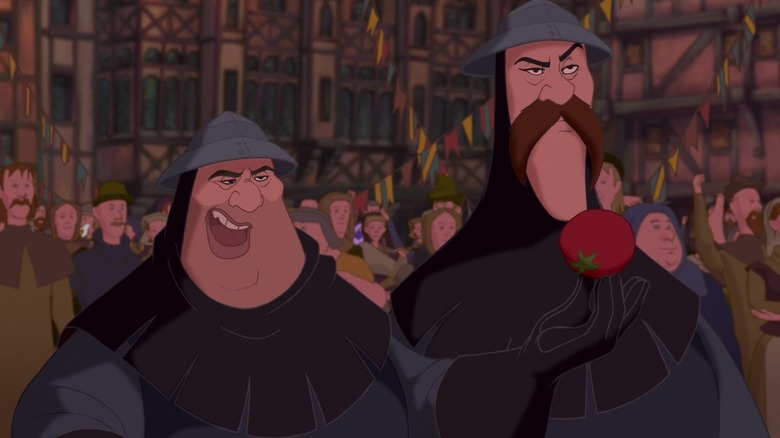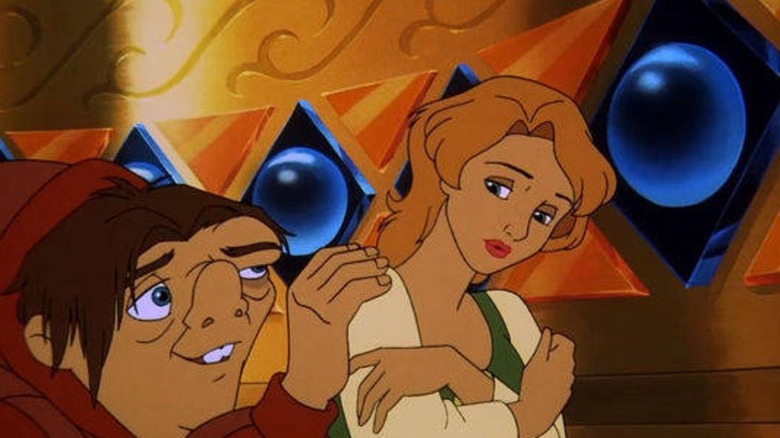The Untold Truth Of Disney's The Hunchback Of Notre Dame
When you think of movies from the Disney Renaissance, that golden period spanning most of the 1990s, "The Hunchback of Notre Dame" is probably not the first title to come to mind. Adapted from one of the most depressing novels of all time, the movie pushes the boundaries of acceptable subject matter for children's films. Even one of its stars — who is also one of the movie's biggest fans — prevented his young son from watching "Hunchback" at the time of its release. One of the most fascinating aspects of this film's history is, in fact, how it scraped a G rating, as opposed to the audience-limiting PG.
However, somber content isn't all that makes "Hunchback" groundbreaking. The film's writers, animators, and musicians were determined to create a movie with a more mature artistic vision and tone than previous Disney features. And yeah, they threw in some gargoyles — but they succeeded. The untold truth of "The Hunchback of Notre Dame" is that it was ahead of its time in every respect. We're here to tell its full story, at long last.
Hunchback is a spiritual sequel to Beauty and the Beast
In 1993, Disney dream team Kirk Wise and Gary Trousdale were working on an animated movie called "Song of the Sea," which Wise would later describe as "the Orpheus legend, but with humpback whales." Then, they got a phone call from then-chairman of Walt Disney Studios Jeffrey Katzenberg, who informed them they would now be directing an adaptation of Victor Hugo's "The Hunchback of Notre Dame."
Wise and Trousdale weren't exactly feature-directing veterans, but they did have a perfect score when it came to Oscar nominations. The pair had worked on a few of the same Disney projects before directly collaborating for the first time on "The Rescuers Down Under" — from which they were both fired. "We asked too many questions," Trousdale explained. They reunited for their directorial debut, "Beauty and the Beast," which proved to be an enormous success. It became the first animated feature to be nominated for the Academy Award for Best Picture, in addition to the five other nominations it received (two of which resulted in wins).
Wise and Trousdale took a break from directing after the grueling "Beauty" process. But once Katzenberg ordained "Hunchback" as their follow-up, they became determined to push the boundaries of animation like never before.
Victor Hugo's novel presented several un-Disney-ish themes
Despite its reputation for delivering happily-ever-afters, Disney frequently draws on grim source material. Even so, Victor Hugo's 1831 novel, "The Hunchback of Notre Dame,” might be the least obvious choice for cartoon adaptation they could have possibly gone with.
Hugo's tome is a chronicle of human tragedy. Archdeacon Frollo and Quasimodo fall in love with Esmeralda, as they do in the movie. But in the book, Frollo orders Quasimodo to kidnap her. This plan is thwarted, and Quasimodo is arrested. In time, Esmeralda falls in love with Phoebus, who is considerably less charming than he is the movie. Frollo makes an attempt on his life, for which Esmeralda is blamed. After Esmeralda refuses his advances, Frollo hands her over to the authorities. Powerless, Quasimodo can only watch as she is hanged. Filled with rage and grief, he hurls Frollo to his death, then vanishes. Years later, his skeleton is found clutching hers in a mass pauper's grave.
Adding singing gargoyles was not going to be enough to make this palatable for children. Fortunately (and somewhat surprisingly), the "Hunchback" team had the full support of Disney executives. Screenwriter Tom Murphy even recalled that Roy E. Disney and Michael Eisner told him, "You write the story you want to tell, and let us worry about our brand."
The team was given unheard-of access to Notre Dame
Where better to learn how to bring Paris to life onscreen than Paris itself? Early into production, the core "Hunchback" team went to the City of Lights to gather inspiration. They were even allowed unprecedented access to Notre Dame. Kirk Wise can precisely recall the moment he discovered the feeling he wanted the movie to conjure: He was "listening to this pipe organ in this shadowy cathedral, with light filtering through the stained-glass windows ... I could feel it thudding in my chest."
A similar moment inspired lyricist Stephen Schwartz to write "Out There." With composer Alan Menken's tune already in place, he sat in the bell tower early in the morning, before the public was allowed in. Schwartz looked out over Paris and felt himself fully inhabit Quasimodo's world: "By the time we left Paris, the song was written."
France also came to Disney, in the form of French artists (and twin brothers) Paul and Gaëtan Brizzi, who storyboarded several sequences including "Bells of Notre Dame" and "Hellfire." This whiff of authenticity may have helped win over French audiences.
Casting Quasimodo created real-life drama
The filmmakers went through hellfire to cast the voice of Quasimodo. One unexpected candidate was legendary rocker Meat Loaf, who auditioned for the directors and composer Alan Menken. "He was terrific," Wise said, though he didn't get the part.
The most memorable audition, however, came courtesy of Mandy Patinkin, best known for "The Princess Bride" and "Homeland." In what has since been dubbed "The Patinkin Incident," the actor arrived at his audition with his own accompanist. Moreover, this accompanist had rearranged the audition song. These etiquette breaches didn't go down well with Menken and lyricist Stephen Schwartz.
Schwartz later said that when Patinkin was taking longer than expected with the audition, he suggested they hurry up, out of respect for the next candidate. That led to an argument. Patinkin and the directors then went into the hall to talk about dialogue. After a few minutes, Patinkin left that conversation and marched back into the room — at which point, as Wise put it, "the fireworks really started." All's well that ends well, though: Patinkin later played Quasimodo in a cable movie.
Disney's pick for Quasimodo, Tom Hulce, was actually nervous about taking the role. But when the directors heard his audio for the scene in which Quasimodo releases a bird he's been nursing, they knew he was the guy they'd been looking for. The take was so heartfelt that it not only got him the part, it's the one used in the movie.
Not everyone had Demi Moore in mind for Esmeralda
In the mid '90s, Demi Moore was one of the most in-demand movie stars in Hollywood. Having found fame as a member of the so-called "Brat Pack," Moore went on to star in hits including "Ghost," "A Few Good Men," and "Indecent Proposal."
However, she wasn't Jeffrey Katzenberg's number-one choice for the role of Esmeralda. As supervising animator and storyboarder Will Finn told Slash Film, the executive wanted Cher for the role. Even Wise and Trousdale didn't think of approaching Moore — but only because they didn't know they could. Originally, they told Katzenberg they were thinking of "a Demi Moore-type person" for the role. Katzenberg gave them a look Trousdale described as "you idiots," and asked why they didn't just get Moore. "We didn't know we were allowed to," Trousdale admitted.
Reports about Moore being "demanding" turned out to be false: "She was a total professional," Wise said. As detail-oriented Disney fans will note, however, Esmeralda's singing voice was provided by Broadway star Heidi Mollenhauer.
Grappling with gargoyles
Most Disney movies contain an element of comic relief, often in the form of silly sidekicks. "Hunchback" leans on this trope too, via Esmeralda's goat Djali, Phoebus's horse Achilles, and Quasimodo's gargoyle friends. But introducing singing gargoyles into a story this intense didn't go down well with everyone.
The gargoyles' personalities changed dramatically throughout production. Initially, they were going to be voiced by three of the era's most famous late show hosts, Jay Leno, David Letterman, and Arsenio Hall. Cyndi Lauper and Sam McMurray were also nearly cast until Roy Disney himself vetoed them. Ultimately, the gargoyles were played by Charles Kimbrough (Victor), Mary Wickes (Laverne), and Jason Alexander (Hugo, whose antics make George Costanza's worst moments look relatively mild.) Wickes died during production, and Jane Withers provided Laverne's remaining dialogue.
Some viewers feel that goofy gargoyles don't fit the movie's intense subject matter. As it turns out, a lot of the people who worked on the movie agree. In Slash Film's oral history of "Hunchback," then-president of Disney Feature Animation Peter Schneider described their presence as "icky," while writer Brenda Chapman admitted, "I wasn't sure if I liked how it ended up."
There is also persistent confusion over whether the gargoyles really come to life, or if it's all in Quasimodo's head. According to Alexander, this ambiguity is the point: "Whatever you believe about it, I'm going to say you're right."
Hunchback contains two of Disney's riskiest songs
Though the entire movie pushes boundaries, there are two songs in "Hunchback" audiences find especially shocking. The first is "Hellfire," in which Frollo struggles between bigoted piety and overpowering lust for Esmeralda. The sequence was storyboarded by Paul and Gaëtan Brizzi, who initially depicted the vision of Esmeralda who dances in the flames as naked. That idea was shot down, but to everyone's surprise, the studio changed nothing else. The demonic judges, the references to "burning desire," the use of crucifixion imagery — Disney was willing to back it all, and then some. The filmmakers were even able to get around the MPAA's rejection of the word "sin" by raising the volume on the sound effects around the word, rather than cutting it completely.
The other eyebrow-raising song is controversial for very different reasons. "A Guy Like You," performed by Quasimodo and the gargoyles, is a major tonal deviation from the rest of the movie. Lyricist Stephen Schwartz was always unenthusiastic about it, but director Kirk Wise described the song as a necessary interlude, intended to keep the audience from "sitting in this trough of despair for so long."
Alan Menken believes Hunchback is some of his best work
If you're a connoisseur of the Disney Renaissance, then you've probably loved a song by Alan Menken. He composed the scores for "The Little Mermaid," "Beauty and the Beast," "Aladdin," and "Pocahontas" before tackling "Hunchback." He went on to write the scores for "Hercules" and "Tangled."
Menken won various Oscars for the first four of those movies (and was nominated for the others), including Best Original Musical Score for "Pocahontas" and Best Original Song for "Colors of the Wind." He shares both trophies with "Hunchback" lyricist Stephen Schwartz. Although less established at Disney than Menken, Schwartz went on to earn major acclaim for the lyrics to DreamWorks' 1998 musical, "The Prince of Egypt."
Out of the ocean of culture-shaping music he's created, Menken is most proud of the work he did on "Hunchback." As he told Slash Film, "It's the most ambitious score I've ever written." Schwartz agreed that it's Menken's "best score" — and one of his own. "I think the music is just unbelievably good," he said. "I think, as a lyricist, I was working at pretty much the top of my form. I have so many people telling me it's their favorite Disney film." Their collaborators agree. According to Jason Alexander, "Hunchback" boasts "the singularly most sophisticated score of most of the animated films of that era."
Creating the crowd scenes was an animation challenge
When "Hunchback" came out in 1996, animation had come a long way since Walt Disney's day. But creating the crowds depicted in the film's festival and mob sequences was still a major undertaking.
Most of "Hunchback" was animated the old-fashioned way: With carefully hand-drawn pictures, painstakingly sequenced to create the appearance of motion. This is a lengthy enough process with just one character, let alone hundreds. For those crowd scenes, the CGI department, led by Kiran Joshi, used then-cutting edge computer software to create several animated character templates. Each was then repurposed dozens of times with different outfits, hairstyles, and accessories. All of these models were then added into the scene and choreographed to respond to the main action. The effect is a crowd that looks like it's made of individuals, created in a fraction of the time a hand-drawn version would have taken.
Frollo may be Disney's most evil villain
Many Disney villains are so over-the-top, they're more fascinating — or funny — than frightening. But there's nothing funny about Frollo – his evil is deeply and recognizably human. The power he seeks isn't over an abstract group: He specifically wants to control Esmeralda and destroy her community. He is so clearly evil that Disney specifically changed his position from archdeacon, as it is in the novel, to judge, so as not to insult the church.
The scene in which Frollo threatens Esmeralda inside the cathedral has a distinctly disturbing tone — at least, if you're an adult. As the "Hunchback" filmmakers recall, they thought they were going to have a battle on their hands trying to keep that especially sinister moment in the movie. Surprisingly, they only had to make one change. According to director Kirk Wise, the ratings board was most troubled by Frollo audibly sniffing Esmeralda's hair. When the filmmakers agreed to lower the volume of the sniff, they were given their "G" rating — a very important thing for a Disney animated movie to have.
For all his menace, Frollo has at least one devoted fan: His supervising animator, Kathy Zielinski. "I love my character. He's the best villain I've ever worked on. I'm just so tickled, being able to do such an evil person," she revealed in a behind-the-scenes featurette.
The team squeezed in some in-jokes
Although "Hunchback" is a more serious Disney movie, the animators working on it still made room for in-jokes. There's a reason some of the most brilliant Easter eggs of the last decade are in Disney movies, after all: They're darn good at hiding them.
"Hunchback" has multiple connections to the studio's 1991 mega-hit, "Beauty and the Beast." Most obviously, it reunited directors Kirk Wise and Gary Trousdale, and composer Alan Menken and lyricist Stephen Schwartz. In honor of their previous project, a special guest makes an appearance early on: Belle can be seen walking through the market square during "Out There." Naturally, she's reading as she strolls. Other Disney cameos can be glimpsed in that moment, including the Magic Carpet from "Aladdin" and Pumbaa from "The Lion King." Maybe don't point that latter reference out to the kids, though: Pumbaa is being set up to be roasted on a spit!
Another in-joke is hidden in plain sight, though only the most hardcore animation nerds will notice it. Phoebus has the honor of being the first modern Disney hero to have facial hair, a tongue-in-cheek homage to Jeffrey Katzenberg. As Kirk Wise recalled, Katzenberg was famously against characters having facial hair. So, when he left the studio during production on "Hunchback," the filmmakers jumped at the opportunity to express their newfound freedom by endowing their leading man with a jaw-defining beard.
The critics were mixed on Hunchback
"Hunchback" remains one of Disney's most ambitious movies. Between the adventurous animation, searing score, distinctly morbid source material, and attempted blend of comedy and drama, the film pushes the limits of people's expectations for an animated movie.
Although the studio had been supportive during production, the Disney marketing team leaned as far away as possible from the movie's darker themes. It presented "Hunchback" as a colorful carnival, entreating moviegoers to "Join the party!" Producer Don Hahn later admitted that he wouldn't go along with this misdirection if given another chance. Moreover, shortly before "Hunchback" was released, Jason Alexander — one of the project's best-known actors — said that although he loved the movie, he wouldn't want his young son to see it. It didn't matter that Alexander was (and remains) one of the movie's most ardent champions — the damage was done.
Some critics appreciated the mature themes and style "Hunchback" invokes, but those who wanted a pure Disney distraction couldn't wrap their heads around it. The movie ultimately made just over three times its budget: A success for any studio other than Disney, then coming off the phenomenon that was "The Lion King." Despite this mixed reception, the movie's creators remain proud of "Hunchback." As Wise told Slash Film, "I've had so many people come up to me and say, 'This is my absolute favorite movie.' ... That makes all the difference in the world."
Hunchback lived on — and went on live
The relatively lackluster box office performance of "Hunchback" didn't save it from the indignity of a direct-to-video sequel: "The Hunchback of Notre Dame 2: The Secret of the Bell" was released in 2002. Believe it or not, the main cast returned, except for Tony Jay's Frollo. Surprisingly, given critical backlash to their silliness, this sequel focuses heavily on the gargoyles, who help Quasimodo save one of Notre Dame's most illustrious bells. The bellringer also finally finds love with circus performer Madellaine (Jennifer Love Hewitt).
To say the sequel is a step down from the 1996 feature is a major understatement. Luckily, that's not the only production to build upon the "Hunchback" story. In 2014, a stage musical version of the film debuted at California's La Jolla Playhouse. This adaptation blends elements from the original novel with those of the Disney film, and retains the movie's songs — except for "A Guy Like You," which was deemed to be too comical.
Ultimately, the musical didn't make it to Broadway. But in recent years, rumors have begun to swirl that Disney will be making a live-action "Hunchback" remake, in line with recent efforts like 2019's "The Lion King" and 2020's "Mulan." Will moviegoers soon be watching Josh Gad swing from cathedral spires? Stay tuned.
